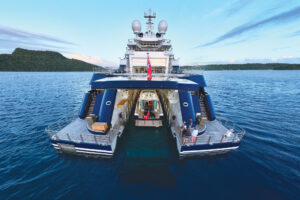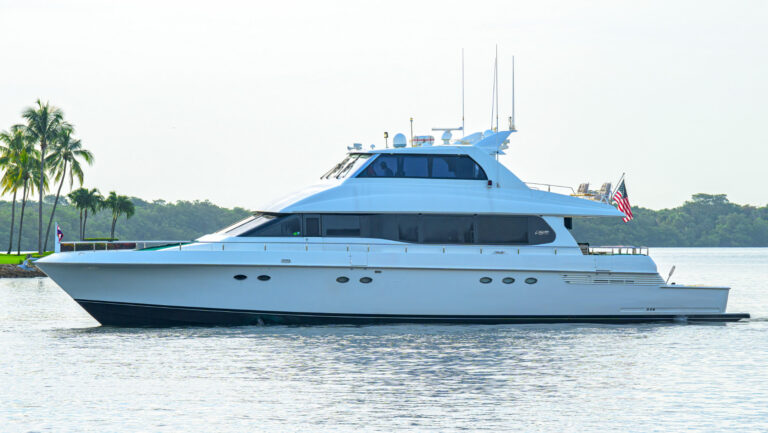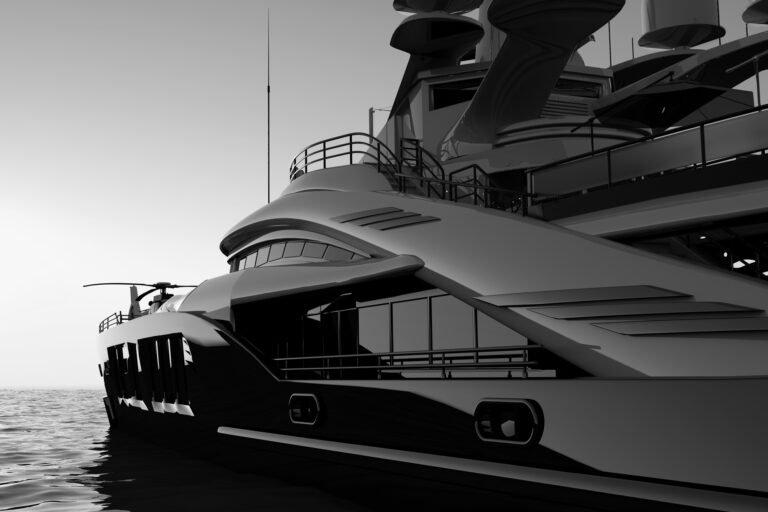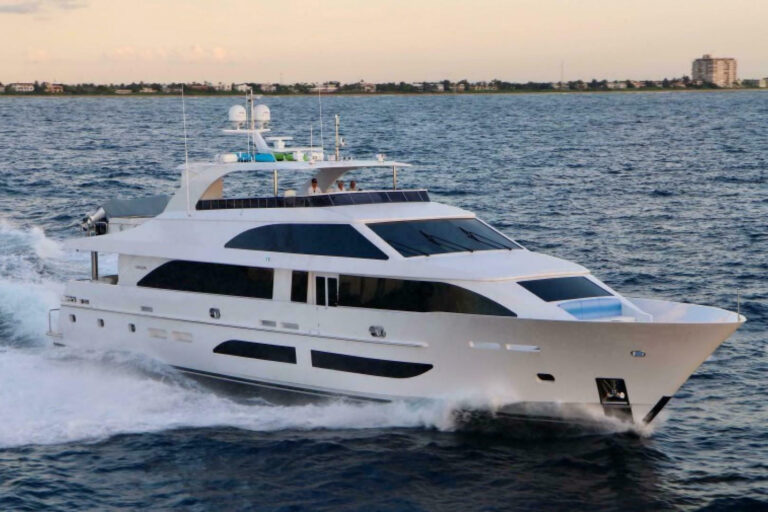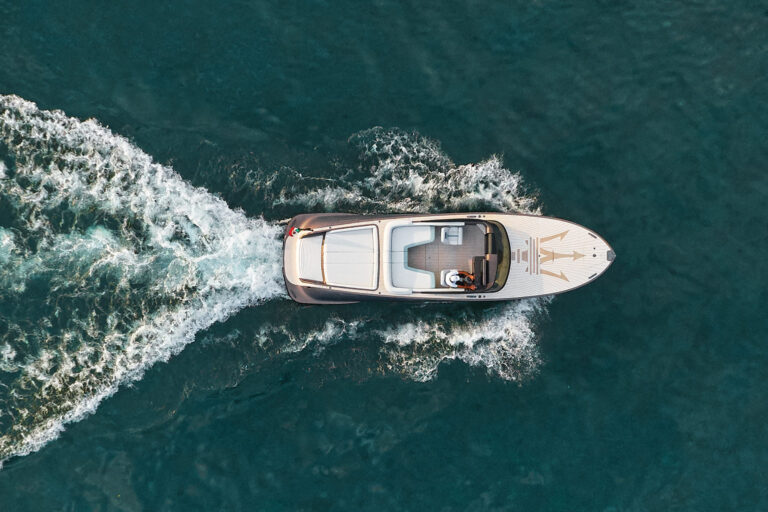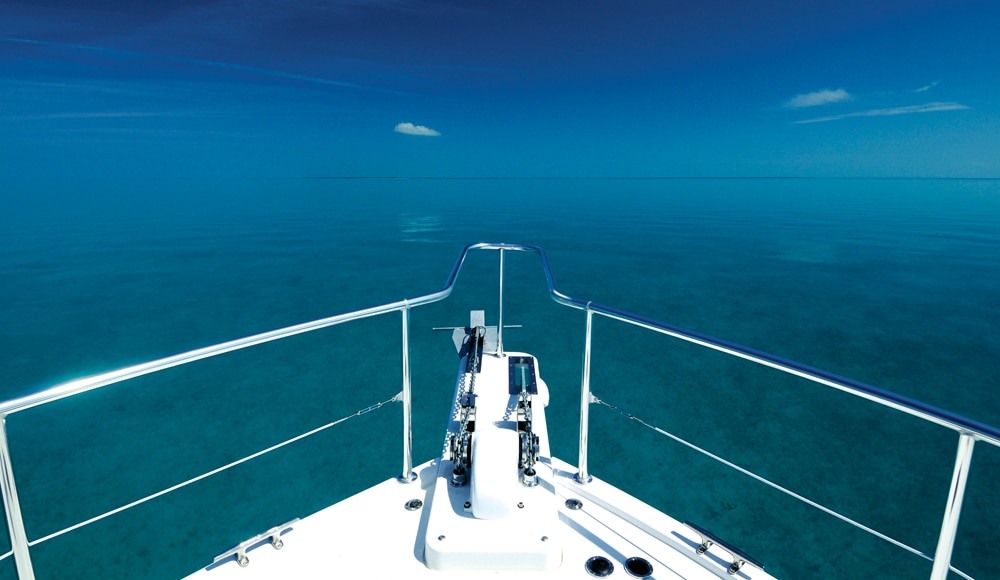
The Gulf Stream Current – A 45-Mile Wide River
Many of us on the East Coast know that a cruising and fishing paradise awaits in the Bahamas. Crystal-clear, protected waters; pure white, sandy beaches dotted with swinging palm trees; an ocean full of fish, and a variety of picture-perfect islands — often within a couple of miles of each other — all come together to create the ideal cruising destination. Perhaps what attracts us most is the islands’ close proximity to U.S. waters. Numerous ports of entry are within 50 or 60 miles of the most popular boating centers in southern Florida.
Before you get to paradise, though, you have to cross the Gulf Stream current, a virtual river within the Atlantic that’s 45 miles wide and flowing north at about 2.5 knots. Choose the wrong time, when a strong wind is out of the north blowing against the current, and you’ll find this a dangerous place to be in any size boat. But with careful planning, preparation and patience, even small, center-console boats can, and do, comfortably make the trip across the Gulf Stream current.
Preparing and Timing Your Gulf Stream Crossing
The most popular ports of departure are Miami, Fort Lauderdale and Palm Beach, and with several Bahamian ports of entry less than 60 miles away, powerboats running between 16 and 20 knots can reach the Bahamas safely in less than three hours. If you’re sailing, you’ll probably spend another six or seven hours in the Stream, and you’ll need to consider that for every one of these hours your boat is being pushed north 2.5 nautical miles. A basic knowledge of navigation (and not just reliance on an electronic chart plotter) is a prerequisite for making the crossing.
While waiting for the right weather is undoubtedly the most important factor for a safe passage, you need to begin by preparing your boat properly for an offshore voyage. Assuming your vessel is of sound design, you’ll want to prepare it for any number of contingencies. See “Safety Check” for my own checklist that I use before making such a passage across the Gulf Stream current.
Patience is the key to crossing, especially during the winter. You’ll want to wait for a good weather window that ensures a southern breeze of no more than 15 knots. It’s best if you can cross a day after the winds have been blowing from the south or southeast and while they’re still blowing from the south. Crossing with strong northerlies must be avoided, as they can create dangerous conditions. You may have to wait a week or two in the fall and winter before conditions are right, so try to avoid tight schedules that can’t be changed.
Listening to the WX channel on your VHF is one source of information, but today there are many other resources that provide more exacting, up-to-date weather data. I subscribe to www.buoyweather.com, which I have found to be very helpful in planning a number of passages. I also check the National Oceanic and Atmospheric Administration website (www.weather.gov/om/marine), which not only provides a forecast of conditions off the coast of Florida out to 60 nautical miles but also gives the recent location of the constantly moving Gulf Stream current.
Honing Your Navigation Skills
Good navigation skills using paper charts really add to your margin of safety. If you rely only on electronics, and the gear suffers a failure, you could easily miss your targeted destination due to the Stream’s strong current. Refresh your vector plotting skills to determine the correct course to steer after compensating for current and wind conditions. Plot that course on your paper chart, and remember that the slower your boat’s speed, the greater the effect of the Stream. With a slow boat, it’s best to cross the Stream at right angles rather than angle into it the entire way. Head more south for the first several miles of your trip, then fall off and cross at right angles, eventually heading back toward your target after you’re out of the strongest part.
Choosing the right time of day to leave is also important and will depend on the speed of your boat. Some slower boats prefer a night crossing to ensure arrival during daylight. Just be aware of the commercial traffic you’ll undoubtedly experience close to the Florida coast. Try to arrive late in the day when the sun is behind you. The closest ports of entry include Bimini, Cat Cay, West End and Lucaya. You might consider crossing the Stream during daylight and passing these popular ports for a nighttime crossing of the less busy Great Bahama Bank, arriving at Great Harbour or Chub Cay in the Berrys during the day. Headed to the Abacos, I’ve crossed the Little Bahama Bank at night, anchoring in Great Sale Cay and then clearing later that morning in Spanish Cay.
Legal Requirement of Entry
Clearing customs and immigration in the Bahamas now requires every U.S. citizen to have a passport, regardless of age. Even babies must have one. Currently there is a $150 cruising fee for boats up to 35 feet and $300 for boats longer than 35 feet. The cruising permit is good for a one-year stay in the Bahamas, but a boat can depart and return within 90 days without having to pay the fee again. If you’re traveling with a pet, you’ll need to get a permit before you leave the States. (For details, visit www.bahamas-travel.info/ports_of_entry.htm.) Pet or not, protocol requires that you hoist a yellow quarantine flag when you approach a port of entry and that only the captain leave the boat until cleared. You’ll need everyone’s passports, your boat’s registration/ documentation, pet permit and firearms information.
Crossing the Gulf Stream can be as easy as a day trip on Long Island Sound or Chesapeake Bay, but it can also be a challenging undertaking that can have unfortunate consequences. It all depends on your planning, preparation and, above all, patience for the right weather window. Do it the right way, and you’ll discover that a whole new world of beautiful islands and wonderfully friendly people await you.
Safety Check
Take these seven essential steps before you head over the horizon.
Life Raft:
Whether you own or rent, don’t cross the Stream without one. Be sure that it has been serviced and certified within the time period recommended by the manufacturer. In most cases this is every two to three years.
Ditch Bag:
In addition to what your raft might include, have a waterproof bag ready with bottled water, essential medications, snack bars, flares, a handheld VHF, signal mirror and handheld GPS. If my boat didn’t have an EPIRB, I’d have one ready in my ditch bag.
Life Jackets:
Crossing the Stream is serious business, so you’ll want serious life jackets for everyone on board. Invest in type I offshore life jackets designed to turn unconscious swimmers from a face-down to a face-up position.
MOB Gear:
I use the Lifesling recovery system, which I have mounted in my cockpit ready for tossing. I also have heavy-duty eye bolts installed in my cockpit’s overhang for attaching a lifting tackle system, which makes it possible for my wife to pull me in. Most importantly, practice man-overboard maneuvers, and make sure you and your mate know what to do if the unthinkable happens.
Fuel, Filters, Impellers, Engine Fluids and More:
Top off your tanks with clean fuel and start your voyage with new fuel filters. Chances are you’re going to experience some turbulence, which will loosen settled dirt in your fuel tanks. Unless recently changed, I make it a habit of changing my oil before I head offshore. Carry spare fuel and oil filters with you. Just to be safe, I also inspect my engine’s water pump impeller and carry a couple of spares. Check your coolant level and carry a gallon or two of what your engine manufacturer recommends. Check all belts and make sure there is a complete set of spares on board. I carry all these spares not necessarily because I anticipate trouble during my three-hour crossing, but because I don’t want to be looking for engine parts while in paradise.
Through-Hulls:
Trying to find the source of incoming water when you’re being tossed around in the ocean can be frightening, especially if you’re not sure where all your through-hulls are located. Know where they are and label them. Be certain they’re serviced on a regular basis, and carry a supply of plugs made of wood or high-impact plastic.
EPIRB:
Today, the reasonable costs of EPIRBs make it hard to justify not having one. Being found and rescued in the Stream can be challenging to rescue crews because of the strong currents and changing weather patterns. Be sure you register your EPIRB and keep the information up to date, following the manufacturer’s recommendations.

